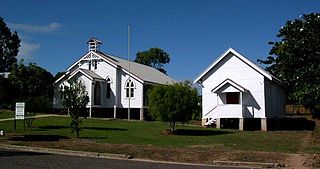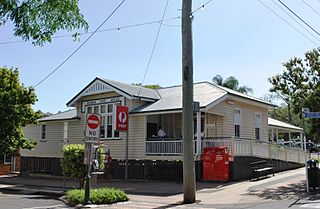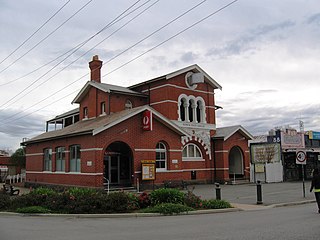
St Agnes Anglican Church is a heritage-listed churchyard at Ipswich Street, Esk, Somerset Region, Queensland, Australia. It was designed by John Hingeston Buckeridge and built in 1889 by Lars Andersen. It is also known as St Agnes Rectory and Church Hall. It was added to the Queensland Heritage Register on 21 October 1992.

St John's Anglican Church Precinct is a heritage-listed churchyard at 30-34 Macrossan Street, South Townsville, City of Townsville, Queensland, Australia. It was built from c. 1907 to c. 1911. It was added to the Queensland Heritage Register on 21 October 1992.

Burketown Post Office is a heritage-listed former post office at Musgrave Street, Burketown, Shire of Burke, Queensland, Australia. It was designed by George Connolly and built in 1887. It is also known as Burketown Tourist Information Centre. It was added to the Queensland Heritage Register on 1 January 1993.

Cobar Post Office is a heritage-listed post office at 47 Linsley Street, Cobar, New South Wales, Australia. It was designed by James Barnet in 1885. It was added to the Australian Commonwealth Heritage List on 22 August 2012.

Narrabri Post Office is a heritage-listed post office at 138-140 Maitland Street, Narrabri, New South Wales, Australia. It is also known as Narrabri Post Office and former Telegraph Office. It was designed by the NSW Colonial Architect's Office under James Barnet and built by FA King in 1888. It was added to the Australian Commonwealth Heritage List on 08 November 2011.

Botany Post Office is a heritage-listed post office at 2 Banksia Street, Botany, Sydney, New South Wales, Australia. It was added to the Australian Commonwealth Heritage List on 8 November 2011.

Ayr Post Office is a heritage-listed post office at 155 Queen Street, Ayr, Shire of Burdekin, Queensland, Australia. It was designed by the Commonwealth Department of Interior and was built in 1936. It was added to the Australian Commonwealth Heritage List on 22 August 2012.

Boonah Post Office is a heritage-listed post office at 1 Park Street, Boonah, Scenic Rim Region, Queensland, Australia. The building was designed by the Queensland Government Architect's Office. It was added to the Australian Commonwealth Heritage List on 8 November 2011.

Bowen Post Office is a heritage-listed post office at 46 Herbert Street, Bowen, Queensland, Australia. It was designed by the Commonwealth Department of the Interior and constructed in 1936. It was added to the Australian Commonwealth Heritage List on 8 November 2011.

Bundaberg Post Office is a heritage-listed post office at 155a Bourbong Street, Bundaberg Central, Bundaberg, Bundaberg Region, Queensland, Australia. It was added to the Australian Commonwealth Heritage List on 8 November 2011.

Charters Towers Post Office is a heritage-listed post office at 17 Gill Street, Charters Towers City, Charters Towers, Charters Towers Region, Queensland, Australia. It was added to the Australian Commonwealth Heritage List on 8 November 2011.

Stanthorpe Post Office is a heritage-listed post office at 14 Maryland Street, Stanthorpe, Southern Downs Region, Queensland, Australia. It was designed by John Smith Murdoch of the Queensland Government Architect's office and was built by D. Stewart and Co in 1901. It was added to the Australian Commonwealth Heritage List on 22 June 2004.

Cooroy Post Office is a heritage-listed post office at 33 Maple Street, Cooroy, Shire of Noosa, Queensland, Australia. It was designed by Thomas Pye and built in 1914 by L. Baldry. It was added to the Australian Commonwealth Heritage List on 22 August 2012.

Maryborough Post Office is a heritage-listed post office at 227 Bazaar Street, Maryborough, Fraser Coast Region, Queensland, Australia. It was designed by Charles Tiffin and built in 1865-1866. It was added to the Australian Commonwealth Heritage List on 8 November 2011.

Euroa Post Office is a heritage-listed post office at 90 Binney Street, Euroa, Victoria, Australia. It was designed by John Thomas Kelleher of the state Public Works Department, possibly with the assistance of A. J. McDonald, and built in 1890 by George Diggle. It was added to the Australian Commonwealth Heritage List on 22 August 2012.

Kerang Post Office is a heritage-listed post office at 51-53 Victoria Street, Kerang, Victoria, Australia. It was designed by the Victorian Colonial Architect, George William Watson, and was built in 1886. It was added to the Australian Commonwealth Heritage List on 8 November 2011.

Leongatha Post Office is a heritage-listed post office and former telegraph office at 4 McCartin Street, Leongatha, Victoria, Australia. It was designed by J. B. Cohen of the state Public Works Department for the Commonwealth Government. It was added to the Australian Commonwealth Heritage List on 22 June 2004.

Sorrento Post Office is a heritage-listed post office at 10-16 Ocean Beach Road, Sorrento, Victoria, Australia. It was added to the Australian Commonwealth Heritage List on 22 June 2004.

Northam Post Office is a heritage-listed post office at 239-243 Fitzgerald Street, Northam, Western Australia, Australia. It was added to the Australian Commonwealth Heritage List on 22 June 2004.

Victoria Park Post Office is a heritage-listed post office at 414 Albany Highway, Victoria Park, Western Australia, Australia. It was added to the Australian Commonwealth Heritage List on 22 August 2012.






















